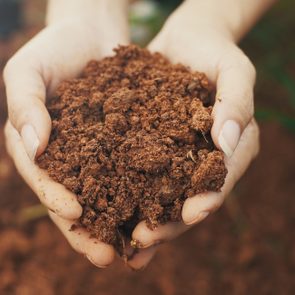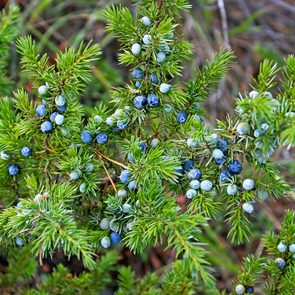How to Use Banana Water for Plants to Make Your Garden Flourish
Updated: May 18, 2023

The latest gardening craze has arrived: banana water for plants. Here's how to make a batch at home to help your plants thrive.
Our editors and experts handpick every product we feature. We may earn a commission from your purchases.
According to trendspotters, plants are the new pets. So it’s no surprise that plant parents are always on the lookout for the next great thing that will help them grow healthier indoor and outdoor companions. In years past, plant lovers were abuzz with news about the benefits of using coffee grounds for plants and eggshells for plants. More recently, home gardeners unearthed a new promising DIY product: homemade banana water.
Stephanie Stephenson, author of Rose Gardening, explains that this recent trend is largely due to the fact that “making banana peel water is easy and simple … not to mention that it is a natural fertilizer for [outdoor and indoor plants].” Bananas are rich in potassium, calcium, phosphorus and magnesium. This combination can stimulate and benefit your plant’s growth.”
If that has you intrigued, read on to learn how to brew a batch to help your plants thrive. You’ll love this trick, and you’ll be so excited about using produce to make your garden grow that you’ll probably want to know more about how to compost too.
Get Birds & Blooms daily newsletter for more gardening and birding tips all week long.
What Is Banana Water?
Banana water is water that is steeped in banana peels. It’s simple to make. Just keep banana peels in water for a few weeks in a jar or bucket, then pour the liquid onto your plants. (We’ll get to the detailed step-by-step process in a minute.) As the theory goes, soaking banana peels releases nutrients like potassium and calcium into the water. This creates an inexpensive, homemade liquid fertilizer.
Does Banana Water Help Plants?
Some gardeners swear by it, but there is currently no scientific evidence to prove that banana water actually contains enough potassium to make a difference for plants. (This doesn’t mean that banana water doesn’t work, though. It may just need to be studied a bit more.) But the reasoning behind using banana water is sound: Bananas contain a lot of potassium, which is an essential macronutrient that boosts plant growth, strengthens stems and helps plants better resist drought and pests.
Banana peels need to be broken down in order to release nutrients in a form that plants can use (think compost). A study conducted by Makerere University College suggests that creating banana water with boiled peels may be a more effective way to boost potassium levels, but more research is needed for that too.
What is certain is that many home gardeners insist they’ve noticed a difference with their plants after they’ve used banana water. Aster W. Green, author of Companion Planting in Raised Bed Gardens, notes that, at the very least, using banana water for plants is an “organic way to level up your watering game [and] get away from expensive synthetic fertilizers.”
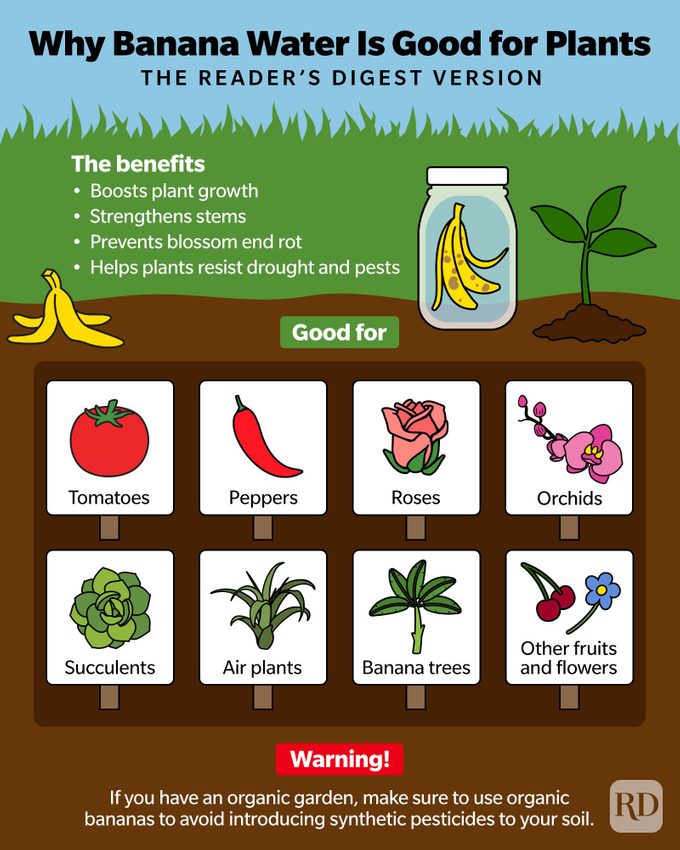
What Plants Like Banana Water?
You can use banana water on any plant in your garden or houseplant collection. While more formal research is needed to determine how effective banana water is, it certainly won’t harm them. Extra potassium is particularly beneficial to fruiting and flowering plants, although all plants can benefit from a bit of added potassium.
If you’re unsure which plants to use banana water on, think “tomatoes, peppers, roses, orchids, succulents, staghorn ferns, air plants and banana trees,” says Stephenson. She says that banana peel water is useful to prevent blossom end rot in tomatoes, which is when the bottom of the tomato starts to turn brown. “Magnesium will aid your flowers and plants with photosynthesis [and] help your plants fruit or flower more easily.”
Is Banana Water Safe for All Plants?
Mostly, yes. Banana water for plants is safe to use, and it won’t inhibit your plant’s growth one bit. However, conventionally grown bananas are often sprayed with synthetic pesticides, so you might not want to use banana water on food crops if you keep an organic garden. One way around this is to brew banana water only with peels from organic bananas.
It is important to note that though banana water does contain some important nutrients, it doesn’t provide everything your plants need to grow. Relying on banana water as your sole source of fertilizer may result in plants with stunted growth, yellowing leaves and other signs of nutritional deficiencies. To avoid this, use banana water in conjunction with other organic products, like compost or fertilizer.
How Do I Make Banana Water for Plants?
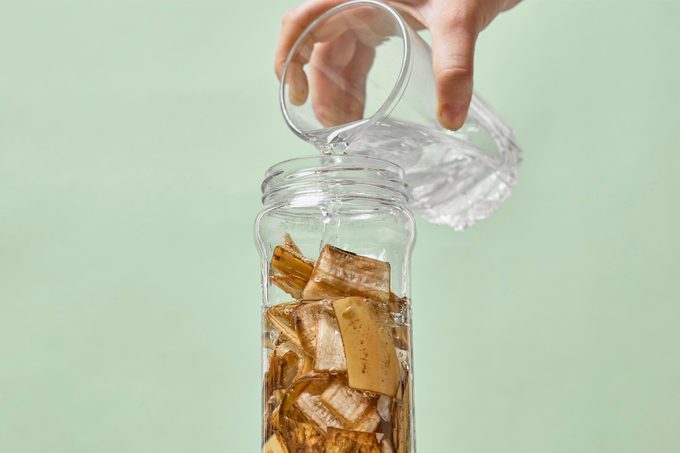
Making banana water for plants is a simple process. All you need are some banana peels, water and a large jar or bucket to brew in. Besides making your plants happier, repurposing banana peels is also an efficient way to reduce food waste and green up your home. Make your own batch by following the steps below.
Step 1: Save your banana peels
After you eat a banana, don’t throw out the peel. “Just take your banana peels and put them into a container and cover two-thirds of the peels with water,” explains Green. Then keep adding peels until you run out of space. Remember to cover the jar to prevent odors and mold.
To help the peels break down faster, try cutting them up into one-inch squares or pulverizing them in your blender before adding them to the jar.
Step 2: Brew the banana water
Once your jar is full of banana peels, put it in a cool, dark place and allow the banana water to steep for two to three weeks. You’ll know your banana water is done when the peels have turned black and the water has darkened. You may notice a slight odor while your banana-peel tea is brewing, but this is normal. Once applied to your plants, banana water should be smell-free.
If you want to make banana water even faster, let your banana peels steep for just a few days. Then add the water and peels to a sauce pan. Boil the mixture for 30 to 45 minutes, and then allow it to cool. This process may help peels release more nutrients. It will provide you with finished banana water much sooner.
Step 3: Remove the peels
After allowing the banana water to steep, strain out the solids and pour the remaining liquid into your watering can. Toss any leftover banana peels into your compost bins to prevent waste.
Step 4: Water your plants
You can use banana water as part of your regular watering schedule with houseplants, container gardens and in-ground beds.
Banana water that is brewed at room temperature can be used once it’s ready. Boiled banana water, on the other hand, is more concentrated and should be diluted before use: one part banana tea to five parts water. Also make sure it has cooled before you pour it onto your garden or containers.
How Often Should I Use Banana Water on My Plants?
Banana water can be applied to most indoor and outdoor plants on a weekly basis as part of your regular plant watering schedule. Simply fill up your watering can with banana water, and water your plants as usual. Just be sure to pour the water at the soil line to avoid damp leaves and mildew. Plants like succulents and cacti that prefer drier conditions should be watered more sparingly in order to prevent issues like root rot.
Is There an Alternative Fertilizer for My Plants?
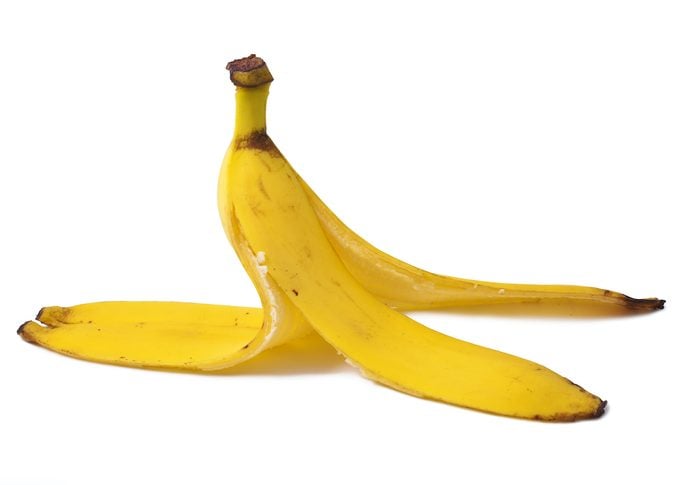
Banana water alone doesn’t provide enough nutrients to maintain healthy plant growth. You may also want to use an organic fertilizer, such as this hydrolized fish and seaweed fertilizer by Neptune’s Harvest or Down to Earth kelp meal fertilizer, both of which contain a nice balance of nutrients.
If you already compost, another way to fertilize your plants is to compost your banana peels rather than make water with them. During the composting process, microbes and beneficial bacteria break down banana peels and other organic matter, making nutrients more readily accessible to plants. You can add composted banana peels as a top dressing to houseplants and garden beds or brew it into compost tea.
Do Banana Peels in the Soil Help Roses Grow Better?
Horticultural expert Melinda Myers says, “This 18th-century practice actually has some merit. Banana peels break down relatively quickly, releasing calcium, magnesium, sulfur, phosphates and sodium for the plant to use. Monitor plant growth and soil fertility to make sure your roses receive sufficient amounts of these and all the other nutrients, including the nitrogen and potassium they need. Chop the peels into small pieces to speed up decomposition so your roses will benefit sooner rather than later. Banana peels also make a great addition to the compost pile if your municipality allows you to include plant-based food waste.”
Sources:
- Stephanie Stephenson, author of Rose Gardening
- Aster W. Green, author of Companion Planting in Raised Bed Gardens
- African Health Sciences: “Overnight soaking or boiling of “Matooke” to reduce potassium content for patients with chronic kidney disease: does it really work?”
- University of Maryland Extension: “Banana Peel Tea”
- University of Minnesota Extension: “Potassium for Crop Production”
- Whitworth University: “Bananas and Pesticides”





















